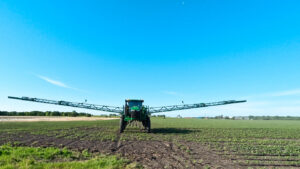Precision ag partnerships are on the rise. Last week Geosys, the satellite imagery company, struck two deals. The first was with Pessl Instruments, a German weather station manufacturer, and the second was with SST Software, a precision ag platform as a service provider. Farmers Edge, the Canadian hardware and software company, also announced a weather deal last week, partnering with IBM’s The Weather Company just a day after Geosys’s announcements.
These deals follow a series of agtech partnerships at the end of last year by aWhere, the agronomic weather data analytics platform, with Sage Insights, the new joint venture between John Deere and DN2K, the company behind MyAgCentral; and AgVerdict, the strategic decision-making toolkit from Wilbur-Ellis, the agriculture marketing and distribution company.
Also last year, Monsanto’s The Climate Corporation partnered with John Deere after selling the hardware business of Precision Planting to the machinery giant. Keeping the software element of Precision Planting — The Climate Corp also has access to data coming off Deere tractors.
Through these partnerships, each party is hoping to increase its footprint and the adoption rate of its technology, a challenge that was widely discussed at the World Agri-Tech Investment Summit last week. This integration is even more important as row crop farmers enter the third year of negative net farm incomes, according to Dave Gebhardt, director strategic partnerships, Geosys.
“Adoption challenges are part of the reason for new partnerships in agtech because of the fact that many technology providers are offering different pieces of an overall system, which makes it more difficult for the end user to decide which pieces to implement,” he told AgFunderNews. “Through vendor collaboration, the customer is getting a more complete solution that’s easier to use and understand. We need to get to a point to where everything works together to provide a more seamlessly automated experience.”
While Wade Barnes, CEO of Farmers Edge, said that his partnership with The Weather Company was more about enhancing its hyper-local weather forecasting ability — the company will continue to deploy weather stations every 2,500 acres on client land — he believes that partnerships will only increase as few companies have the ability or desire to build capabilities in-house.
“At Farmers Edge, we believe we have most of the holes filled in an integrated offering but are still constantly improving our platform. Meanwhile, other agtech companies have many holes to fill or are essentially pegs to fill other companies’ holes. In the future, there will be only two or three true integrated solutions on the market. For someone that is looking to make an investment in agtech, I would look at companies that have a unique product that other groups are missing,” he told AgFunderNews.
Partnerships also about improving the quality of the data available to farmers and used in decision support technology, according to aWhere CEO John Corbett. “The effectiveness of precision agriculture solutions stand to be hugely impacted by poor data – as will information across the agricultural value chain. From research to input providers to markets, supply chains, and commodity risk exposure, accurate data starting on-the-farm will enhance and optimize agriculture even with the increase in weather variability due to a warming climate.”
It’s worth noting that all the companies involved in these partnerships are relatively mature for the young agtech sector. Geosys has been selling satellite imagery for 25 years, Pessl Instruments has been in the market for even longer at 31 years, Farmers Edge is one of the most established integrated precision ag platform players with 10 years under its belt, SST Software is even older launching in 1994 and The Weather Company dates back to the 1970s. aWhere also has 17 years to its name and The Climate Corporation was established 10 years ago.
“More established companies in this industry are partnering with each other because we understand that the most difficult part of agriculture technology is not the technology itself, but the agronomy and access to the market,” said Damien Lepoutre, founder and president of Geosys. “The agricultural IoT doesn’t just happen by itself and no one provider can do it all. Smart companies know they need to work together and go through the established channels in the market to find success. While startups worry about moving quickly and pleasing investors, we focus on how we can provide more value to our customers.”
These companies also have the internal bandwidth, economically and otherwise, to put partnerships like this to work, and see where it gets them in providing farmers a more complete and accurate solution aWhere’s Corbett argued.
So is this all a pre-cursor to consolidation in the precision ag segment of agtech? It’s very likely. And it wouldn’t be crazy to think that some of the established players involved in these partnerships will become acquisitive — AgFunderNews understands that Geosys’ new director of partnerships Gebhardt will be looking for more than just partnerships over the next 18 months, and others will follow suit. In fact, Farmers Edge already acquired sensor business Crop Ventures in 2014.
Consolidation was a big topic of conversation on the sidelines of the World Agri-Tech Investment Summit, often resulting from pessimistic views of the future for many ag data collection and analysis startups.
“I haven’t yet felt comfortable investing in the digital data subsector,” said one sustainability-focused VC. “I haven’t yet seen a company that’s going to make a farmers’ life many times better.” The partner of a large agtech VC agreed: “I want to wait until I can do a distressed roll-up at some point next year.”
With Rabobank predicting that broad acre farm incomes are going to remain at break-even levels for the next five years, potentially impacting agtech adoption, this idea might not be that far-fetched. And this wave of partnerships is a step in a similar direction.
What do you think? How will these partnerships play out and what do they mean for the agtech sector more broadly? Email [email protected].




